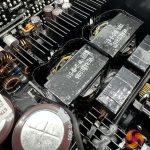
Inside the power supply is a Hong Hua fan, marked HA13525H12SF-Z – a favourite with Seasonic and many other brands. This is a 135 Fluid Dynamic Bearing (FDB) fan, which you can disable under lower load situations with the switch on the back of the unit.
Seasonic say their cable free connection design helps reduce production errors during manual insertion. The Seasonic design is well thought out and perfectly executed from the ground up. Soldering quality is high on the PCB and there are several small rows of heatsinks to keep temperatures in check.
Seasonic are using a full bridge topology inside this power supply with an LLC resonant converter alongside a bridgeless interleaved PFC. The power for the 12V rail is created via 16 FETs. The minor rails are generated by a pair of DC to DC converters.
Titanium efficiency levels will certainly help reduce unwanted heat internally as well. We are pleased to say that the build quality throughout represents what we would expect from a flagship Seasonic design. Soldering quality is also extremely high across the board.
Seasonic are using high grade 105C Japanese capacitors throughout the design, with high grade Nippon Chemi Con caps making up the primary stage. Three massive 420v 820uF capacitors deliver a total of 2460uF. This is significantly higher uF than the 2022 version of this supply which we reviewed back in September 2022 (HERE). Due to this massive capacity we noticed Seasonic have used dual NTC thermistors with 20ohm x2 resistance. These are installed on a vertically mounted board into the main PCB to save horizontal foot print.
The previous version of this power supply that we reviewed in 2022 was not ATX 3.0 compatible, with a peak 2000W limit. This version has upgraded power delivery, primary stage capacitors and is capable of a 3200W peak delivery.
It is very densely populated with a lot of components crammed inside, with a few large heatsinks in various positions – clearly to help reduce temperatures inside the chassis, and the need to spin the fan up to compensate. We all want as little noise as possible.
All in all this is a very impressive design and despite the massive physical size of the unit, it is crammed with components across the board.
 KitGuru KitGuru.net – Tech News | Hardware News | Hardware Reviews | IOS | Mobile | Gaming | Graphics Cards
KitGuru KitGuru.net – Tech News | Hardware News | Hardware Reviews | IOS | Mobile | Gaming | Graphics Cards











